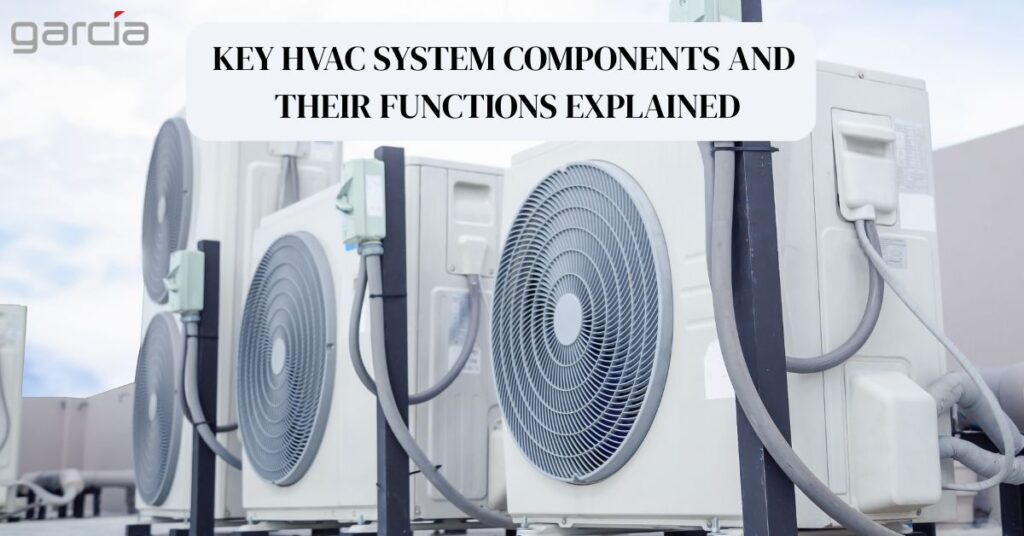Understanding the major HVAC system components is essential for both homeowners and technicians. Whether you own a small house or service a high-rise tower, understanding how these pieces fit together keeps bills low and safety high. In short, the better you know the parts, the smarter your repair or upgrade choice.
In this guide, we’ll break down what are the main components of an HVAC system are, their functions, and why they matter.
To stay up-to-date with emerging technologies, you may also want to explore the latest HVAC trends shaping the industry.
What Are the Main Components of HVAC Systems?
An HVAC system is a combination of mechanical and electronic parts that work together to regulate the indoor climate. Let’s take a closer look at what are the main components of an HVAC system are and their functions:
1. Thermostat
The thermostat, often referred to as the brain of an HVAC system, is responsible for reading the indoor temperature, allowing you to set the desired temperature, and communicating with the rest of the hardware to ensure optimal performance. Some newer models whisper updates to your phone, show weekly energy trends, and play helpfully with those mood lighting apps you might already own. Turn the dial, tap the screen, or holler at the smart speaker the choice is yours.
2. Furnace or Air Handler
The furnace or its cousin, the air handler in an all-electric setup, sits in a utility closet like the muscles of the heating system. A stout blower motor whirls inside, pushing warm air through long metal ducts that snake up into the living room, down into the basement, or even behind the walls. This is one of the largest components of HVAC system setups, especially in colder climates.
3. Evaporator Coil
Nestled within the same air handler, the evaporator coil looks almost like a stacked honeycomb. Humid indoor air kisses the metal fins, leaves behind its warmth, and watches that heat travel off with refrigerant that quietly changes state inside the tubing.
4. Condenser Coil
Installed outdoors, the condenser coil releases heat absorbed by the evaporator. It’s one of the most important parts of HVAC system cooling cycles.
5. Refrigerant Lines
Thin copper tubes tethered between the evaporator and condenser walk refrigerant along its merry way. These lines shuffle the fluid during cooling or even heating when the thermostat feels generous.
6. Ductwork and Vents
A network of sheet-metal passages transports conditioned air from point A to point Z, with wall vents serving as traffic cops in between. Slide a vent’s louvers open and you get a breeze; close them and the airflow learns to behave.
Residential HVAC System Components to Know
In homes, residential HVAC system components are smaller than what you’d find at a factory, yet they pull off the same magic. Learning these bits lets owners spot hiccups early and keep comfort levels from drifting too far.
Air Filters
Most people forget about their air filter until they start sneezing. A new filter effectively traps dust and enables the free flow of either cool or warm air. Swap it out every month, and your system and your lungs should stay happy.
Drain Pans and Lines
Every AC makes water; the trick is getting that water out. Clearing drain pans and lines keeps leaks away and stops mold before it has a chance to grow. Let either clog, and you may suddenly find yourself mopping up a surprising amount of moisture.
Blower Motor
Think of the blower motor as the system’s lungs; without it, air barely moves. The blower motor quietly operates, distributing comfort throughout the entire house. If it quits, rooms can feel like two different seasons at once.
If you’re short a capacitor or need a new blower wheel, local pros usually have what you want. Please visit our HVAC supply in Orange, TX, to pick up the parts and hand tools that will have you back on the ladder or under the hood promptly.
HVAC Components List and Their Functions
Here is a simple HVAC components list and what each part does:
- Compressor: Pumps refrigerant around the loop.
- Expansion Valve: Controls how much refrigerant drips into the evaporator.
- Capacitors: Give motors that first jolt of energy.
- Contactors: Act like traffic lights, letting power flow or holding it back.
- Fan Motor: Cools the condensing coil and keeps the whole system even.
Understanding this HVAC parts and functions list helps contractors and DIYers alike handle basic diagnostics and maintenance.
Most Commonly Replaced Parts of HVAC Systems
Like any mechanical system, certain parts of HVAC unit setups wear down over time. Here are common replacements:
- Capacitors and Contactors: These little discs and switches often quit when the system sees nonstop action.
- Refrigerant Lines: Vibrations or rusting can cause metal tubing to leak.
- Thermostats: Many folks swap a dial or slider for a Wi-Fi smart model.
- Evaporator and Condenser Coils: Fins and shallow tubes often blend, shred, or get blocked with dirt, yet most people ignore them until the unit gasps.
Knowing which parts of HVAC system need regular attention helps prevent costly breakdowns and improves energy efficiency.
Why It’s Important to Understand HVAC System Components
Whether you’re a homeowner trying to reduce your energy bill or a technician working on diagnostics, understanding HVAC system components is critical.
For Homeowners:
- You learn to ring the pros at the first odd noise.
- Routine checkups stop small snags from mushrooming.
- Smart shoppers pick upgrades that actually pay back in lower energy costs.
For Technicians:
- Quick identification of parts expedites the diagnostic process.
- It helps you advise clients on sensible extras instead of pricey overkill.
- Good on-the-spot knowledge means fixes are done in one trip rather than three.
Getting comfy with every vent, valve, and relay helps anybody in the field feel less like a gambler and more like an HVAC pro.
Where to Find HVAC Parts and Functions
Heating and cooling work best when you swap out worn parts for fresh ones. Start your search with a seller who carries
- The seller should carry a complete lineup of compressors, coils, duct pieces, and more.
- Trusted brands and robust, straightforward warranties are also provided.
- We have locations close enough to enable same-day pick-up.
HVAC pros in Southeast Texas often visit a neighborhood distributor for a thermostat one minute and a full system the next. When the weather changes and repairs become urgent, a dependable local shop is invaluable.
Conclusion: Getting to Know Your HVAC System
The functionality of your heating and cooling system depends on how well its parts work together. From the thermostat to the refrigerant lines, every component has a specific job.
By learning about HVAC system components, you can manage your system more effectively, perform timely maintenance, and extend equipment life. Whether you’re a technician looking for tools or a homeowner exploring energy-efficient HVAC upgrades, understanding HVAC parts and functions is the first step to smarter HVAC management.


